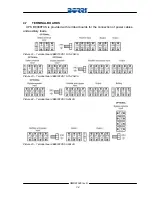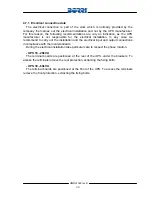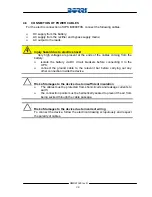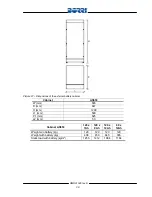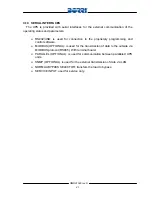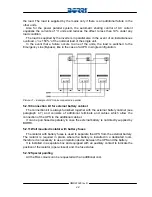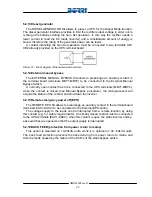
OMD91046 rev D
47
5.2.6 Serial interface RS-485 (Mod-Bus protocol)
It consists of an additional card which must be installed in a specific space provided
on the UPS front. This card contains a “+”, “-“ and “ground” three-pole connector, as
well as a serial port RS485 which must be used for the connection to the MODBUS-
master. The operating parameters of the UPS converted into MODBUS protocol are
also available on this card.
5.2.7 SNMP adapter
On the Evo line, the SNMP adapter can be directly installed on the UPS front. In fact
the standard UPS is already provided with a supply cable as well as with a flat cable to
exchange data with the microprocessor card.
The SNMP adapter converts the communication protocol of the UPS into SNMP
protocol (Simple Network Management Protocol), which belongs to the suite of Internet
protocols, so that all the main information regarding the operation and the conditions of
the UPS is available in the network.
It is also possible to configure the SNMP adapter as an RCCMD (Remote Console
CoMmanD) Server to start a shutdown of one or more PCs when the UPS has a
problem.
To enable this function it is necessary to install the RCCMD software onto each PC
required to start the “shutdown”; (the SNMP adapter has, as standard, only one
shutdown license. Additional licenses must be purchased separately).
5.2.8 Remote panel
The remote panel is used to display 4 independent visual alarms. Each event
activates the flashing of the last LED “General Alarm” and an acoustic signal that can be
silenced by the user. The regular operating conditions of the UPS are indicated by the
lighting of LED “UPS OK”.
5.2.9 Parallel kit
The parallel kit allows to prearrange a UPS configured as a single unit for its
connection and configuration in a parallel redundant system. Thanks to the DSP
microprocessor and to the CAN-BUS communication system, configuring the UPS from
single to parallel operation is very easy, basically plug-and-play. Moreover, the UPS
units composing the parallel system can also be located in different rooms, with a
maximum length of the parallel cable of 50 m.
There are two types of parallel which can configured by software: parallel redundant
and power parallel.
In both cases the system can consist of “n” UPS units (up to 6). Only the manual
bypass can be external and the same for all the units.
The parallel redundant system ensures an uninterrupted power supply even in case
of various failures in the system.
This is possible because all the units are constantly running, and each of them
supplies the load in parallel to the “total load / n”, where “n” is the number of units.
The automatic sharing control of AC current equalizes the currents of “n” units and
reduces the offset to less than 10% under any load condition. The load is supplied by
the inverters in parallel also in the event of an instantaneous overload
“n x 150%” of
the nominal load of the single unit. In case of a failure in one unit, the other units supply


